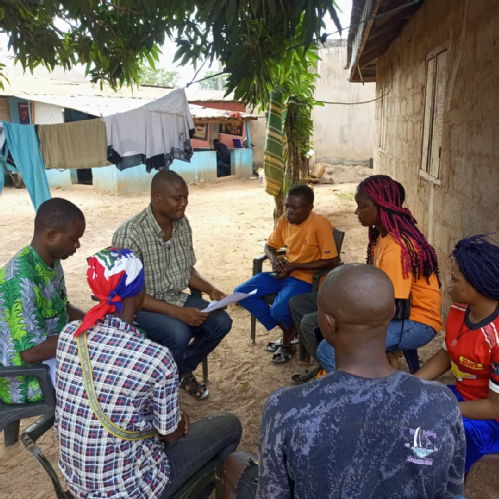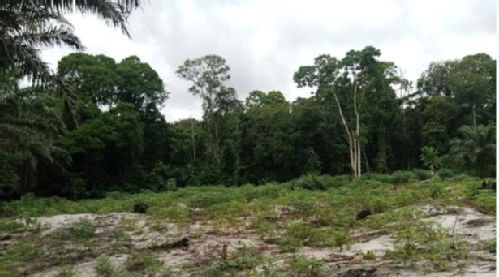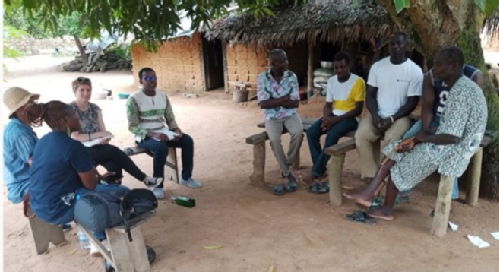All 2 entries tagged Community Engagement
No other Warwick Blogs use the tag Community Engagement on entries | View entries tagged Community Engagement at Technorati | There are no images tagged Community Engagement on this blog
March 14, 2024
Stakeholder Identification and Community Engagement for Data Collection in Marginalised Populations

Ebonyi community engagement during December 2020 data collection on community-based intervention in the control of gender-based violence in Nigeria study (Source: Author)
Written by Aboluwaji Daniel Ayinmoro
Stakeholder identification and community involvement in research are increasingly considered as prerequisites for successful data collection procedures within the global discourse of community engagement. However, there is concern about the low participation of several marginalised populations in data gathering processes because of mistrust, resistance and dissatisfaction brought on by their limited access to opportunities and resources, which are necessary for them to fully participate in society and live a decent live. If this issue is not resolved, it could lead to inaccurate collection of data and insufficient evidence-based policy interventions for marginalised communities.
The situations of marginalised populations and poor participation in data collection
The number of marginalised groups in Nigeria is steadily rising as a result of poverty, conflicts, and natural disasters. The most vulnerable categories of people to the detrimental effects of this situations are those who live in slums, internally displaced people (IDPs), women and people living in rural riverine areas. This is because, among other things, they are the population most at risk of violence and having restricted access to resources like the health care system and portable water. Their level of poverty and social exclusion are made worse by these circumstances. Why poor participation in data collection? There are several reasons for poor participation in most evidence-based policy driven intervention programmes. First, a lack of feedback on the results of earlier data collection efforts has left community members excessively bored with data gathering process. Second, in certain marginalised groups, local authorities always hijack interventions. As a result, each researcher coming for data gathering must be screened by the local authorities before any data collection can begin.
Overcoming the challenges of poor participation in data collection process
There are measures that need to be made to address these difficulties in obtaining reliable data in marginalised areas, based on first-hand experiences in slum and community-based interventions research. The first step in data gathering procedures is to identify the stakeholders. This is necessary for sorting out all parties involved, direct or indirect, based on how the research's findings would impact them. Most studies that span marginalised populations often identify three categories of stakeholders: primary, secondary and key stakeholders.
- Primary stakeholders: They are the community people who stand to be directly affected either positively or negatively by the research efforts. The primary stakeholders in research conducted in most marginalised communities are the community members themselves, including their heads and leaders of community sub-groups (gate keepers and community champions), as they stand to gain from the findings.
- Secondary stakeholders: They are the people who stand to be indirectly affected either positively or negatively by any research effort. The involvement of experts in the study of interest, such as health professionals for health interventions in communities is a good example of secondary stakeholder, while the involvement of community police officers in the study of community-based intervention in the control of gender-based violence is another example of secondary stakeholder.
- Key stakeholders: The key stakeholders are people who belong to either or neither of the first two groups, who can have a positive or negative influence on a research effort. The involvement of the state’s ethics office and the directors in the ministry responsible for the area of research interest are good examples of key stakeholders. Additionally, the funder of a research project can also be regarded as a key stakeholder since their funding will impact significantly on the outcome of the research effort.
Stakeholder mapping or analysis is necessary after the different categories of stakeholders have been identified. This is where the researcher[s] ascertains which stakeholders can have the greatest positive or negative impact on the research project.
Engaging community stakeholders for robust data collection
Researchers are required to take certain actions depending on the responsibilities that various types of stakeholders play in a research project in order to address the issues of mistrust, resistance, and suspicion of researchers by marginalised community members. First, as a key stakeholder in marginalised communities, it is crucial to receive ethical clearance from the state's ethics office. This is where permission to execute the research is granted by the state authorities. Secondly, the inclusion of secondary stakeholders in research pertaining to marginalised populations is recommended, subject to the nature of the study and its relationship to policy interventions. This is because, in addition to validating the data gathering tool, their contributions as professionals on the subject of investigation would act as gatekeepers for the marginalised groups. For example, it is imperative that health professionals be involved in the state of health in slums based on their knowledge of related issues.
While the engagement of the secondary and key stakeholders in data collection procedures in marginalised populations is essential for a successful data collection, the procedures for the engagement of primary stakeholders are more critical. This is because the primary stakeholders do not only remain the direct beneficiaries of the research outcomes but are typically more vulnerable to social exclusion than other categories of stakeholders. However, following the engagement of the key and secondary stakeholders in a research effort or an intervention project, a proper community entry is expected to be done by first informing, consulting and brainstorming with community heads and other leaders of community associations on the focus of the research project. By doing this, it would have yielded high level of adherence to ethical standards and perhaps lowest level of resistance in data collection. Involving the heads of the communities and other sub-group leaders in outreach to the community is the next action that has to be taken. In order to gather data in their communities, it could be feasible to recruit and train them as research assistants. As a result, community people feel more involved in the research project and have more confidence in it. Following data collection, feedback and dissemination workshops are required, with participation from representatives of all stakeholders, including the media. Finally, should the study require supports or interventions from the funder, non-governmental organisations or the government to the community, its implementation must not be disregarded and monitored.
Key conclusion
The key to sustainable community engagement in research within any study population for successful data collection in Nigeria, is building enduring relationships with all stakeholders and making sure that research findings are shared with all subjects. In addition to this, if there is any intervention that arises from the findings of the research, its implementation should not be compromised.
Resources
BMJ Global Health: https://gh.bmj.com/content/5/8/e003042.abstract
Global Call to Action Against Poverty: https://gcap.global/coalition/nigeria-2/
Author’s bio
Aboluwaji Daniel Ayinmoro is a Lecturer at the Department of Sociology, University of Ibadan, Nigeria. He has over five years of experience in teaching and research in Sociology, and Demography and Population Studies. He has expertise in community engagement and mixed-methods research that combines quantitative and qualitative approaches. He can be contacted via boluwajidaniel@ymail.com.
December 05, 2023
Encounters, dialogues and solutions for natural resource management and sustainable development
“L'homme n'est pas le maître de la terre, mais la terre est le maître de l'homme”: Encounters, dialogues and solutions for natural resource management and sustainable development in Côte d’Ivoire.

A view of the Voluntary Natural Reserve(May 2023, Photo Credit, Adou Djané)
Written by:
Adou Djané, Briony Jones, Mouzayian Khalil-Babatunde, Sita Akoko Kondo, Dohouan Village Secretary, Dohouan Forest Guides, and Dohouan Women’s Association.
The current ambitious Sustainable Development Goals (SDGs) framework requires actors to work together to realize sustainable development for all. However, we continue to see the dominance of top-down development despite the fact that local communities are vital for successful and legitimate development interventions. In this blog we present one particular local community action which is part of a joint project on natural resource management in Côte d’Ivoire. Our project “L'homme n'est pas le maître de la terre, mais la terre est le maître de l'homme”: Encounters, dialogues and solutions for natural resource management and sustainable development in Côte d’Ivoire is funded by the University of Warwick as part of an International Partnership Fund and is a collaboration between the Centre Suisse de Recherche Scientifique en Côte d’Ivoire (CSRS) and the University of Warwick. It is also a collaboration with local communities working to manage their natural resources, and it is for this reason that the blog is co-authored by the project partners as well as the local communities interviewed in the framework of this project. What this blog describes is an example of an effective constellation of collaborations for activism to protect a primary rainforest on the border between Côte d’Ivoire and Ghana.
In May 2023 we gathered in the village of Dohouan, in the South-East of Côte d’Ivoire and close to the border with Ghana. It is here that the Tanoe-Ehy Forest is situated, one of the last areas of rainforest in the country, home to three of the most endangered primates in the region, and under threat from conversion to palm oil plantations. We spoke together about the successful block in the expansion of palm oil plantation, and the designation of the forest as a Voluntary Natural Reserve by the Government of Côte d’Ivoire. Two themes are clear in the conversations that we had: (1) for the importance of future generations being able to see, enjoy, and use the forest; and (2) the importance of collaborative action combining local, regional and national actors.

Meeting with the community representatives (May 2023, Photo Credit, Adou Djané)
“Tous, on est impliqué”
These words of the Village Secretary: “We are all responsible” sum up the successful action to block the palm oil plantation expansion into Tanoe-Ehy Forest.
In the 1980s and 1990s, structural adjustment policies, advised by international financial institutions, were implemented in Côte d’Ivoire. This included the privatisation of the previously state-owned Palm industries in 1997. The assets of the company were bought by three private enterprises, significantly reducing the land ownership of smallholders in palm oil producing areas.
The forest is a valuable resource not only for the palm oil companies but for the local communities. There is a daily pleasure in seeing the forest, knowing the names of plants and animals, and being able to use the resources of the forest. This includes plants for medicine, wood for construction of buildings, and the use of flora and fauna in important cultural ceremonies. Successfully saying ‘no’ to the palm oil plantation in the rainforest adjacent to Dohouan is an important example of local community activism in the context of contested management of natural resources.
“Que la fôret demeure fôret”
When asked about key priorities, a group of village representatives told us that first and foremost they wished “the forest to be a forest”.
Supported by a network of voluntary forest guides, the rainforest is protected, and its use managed. The forest guides take great pleasure in the voluntary nature of their work, both directly preserving the forest through patrols and indirectly through educating the local population about the importance of sustainable management of the forest. There are now limits as to how much wood can be used from the forest, which plants can be taken out, a ban on hunting, and limitations placed on fishing.
Before the forest was designated a Voluntary Natural Reserve the local communities in the area participated in workshops to help to decide and define regulations for its management and protection. Representatives of the Government were present to advise on the different options available, but it was the local population who agreed together to request a Voluntary Natural Reserve.
“Je le fait pas pour moi, mais pour les générations de l’avenir”
The fight to save the forest is framed by local residents as a commitment to future generations, as this quote from the forest guides illustrates: “I am doing it not for me, but for future generations”. However, this was not simply a question of local community versus oil plantation company, it was a sustained effort over time through a network of collaborations and associations spanning different levels of governance.
The CSRS first began working with the local communities in the area in 2006, supporting activities around education to counter some depleting local practices while at the same time preserving the forest and its role in community life and sustenance. This initiative by CSRS “captured their attention” and it was then that “the idea of conservation was born”, according to the President of the Fishermen’s Association. It was the CSRS who accompanied local associations on visits to the relevant government ministries, provided information about the rights of the local communities, and supported the workshops which evolved and manifested in the request for classification of the forest as a voluntary natural reserve.
The outcome was a victory for the forest, it is protected and preserved. But it is still an ongoing journey of negotiation between different actors. The forest crosses the border with Ghana, and lack of adequate coordination, partly due to will and partly due to resources, undermine what should be a shared conservation effort. Lack of resources also undermine the work of the forest guides who do not have access to basic equipment such as walkie talkies or permanent patrol posts which would allow them to do their work in the remote setting of the forest.
“L’union fait la force”
These words, spoken by the President of the Fishermen’s Association: “together we’re stronger”, certainly seems a foundation for the past, present and planned activities of conserving the forest.
But this union has cracks, not least a feeling that since the official designation of the forest as a voluntary natural reserve, that the state has washed its hands of supporting in its management. Tensions between Ghanaian and Ivoirian Forest patrols as well as between Ghanaian and Ivoirian fishermen require time and resources to manage sensitively and fairly.
Resources
Recherches et Actions pour la Sauvegarde des Primates en Côte d’Ivoire CI (RASAPCI)
Où sont les colobes rouges de Miss Waldron?, Nature et Environnement
Authors’ Bio
This blog is written collaboratively by researchers in the Centre Suisse de Recherche Scientifique en Côte d’Ivoire (CSRS), the Department of Politics and International Studies University of Warwick, and representatives of the village of Dohouan in the South-East of Côte d’Ivoire by the border with Ghana. The blog is an output of our research project“L'homme n'est pas le maître de la terre, mais la terre est le maître de l'homme”: Encounters, dialogues and solutions for natural resource management and sustainable development in Côte d’Ivoire, funded by the University of Warwick as part of an International Partnership Fund (2022-2024).
 Mouzayian Khalil
Mouzayian Khalil

 Please wait - comments are loading
Please wait - comments are loading
 Loading…
Loading…